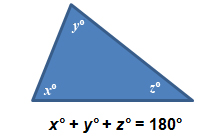
Recall that the sum of the measures of the interior angles of any triangle is 180°.

In this section, you will find the sum of the measures of the interior angles of other polygons and then develop an algebraic representation for the sum of the measures of the interior angles of any polygon.
In your notes, create a table like the one below.
![]() Complete the table by first drawing all possible diagonals from one vertex of each polygon and then filling in the columns that follow. The first two are partially done for you.
Complete the table by first drawing all possible diagonals from one vertex of each polygon and then filling in the columns that follow. The first two are partially done for you.
Check your responses by moving your mouse over the blanks.
Use your notes and the table above to answer the following questions.

Since we know the sum, substitute it in for S(n) and solve for n.
3060 = 180(n − 2)
3060 over 180 3060 180 = 180 (n minus 2) over 180 180 (n − 2) 180 So the polygon has 19 sides.
17 = n − 2
n = 19

If we substitute 2400° in for S(n) and solve for n, we get:
2400 = 180(n − 2)
2400 over 180 2400 180 = 180 (n minus 2) over 180 180 (n − 2) 180
13.3 = n − 2
n = 15.3
But it is not possible to have a polygon with 15.3 sides. Therefore, it's not possible to have a sum of interior angles of 2400°.
